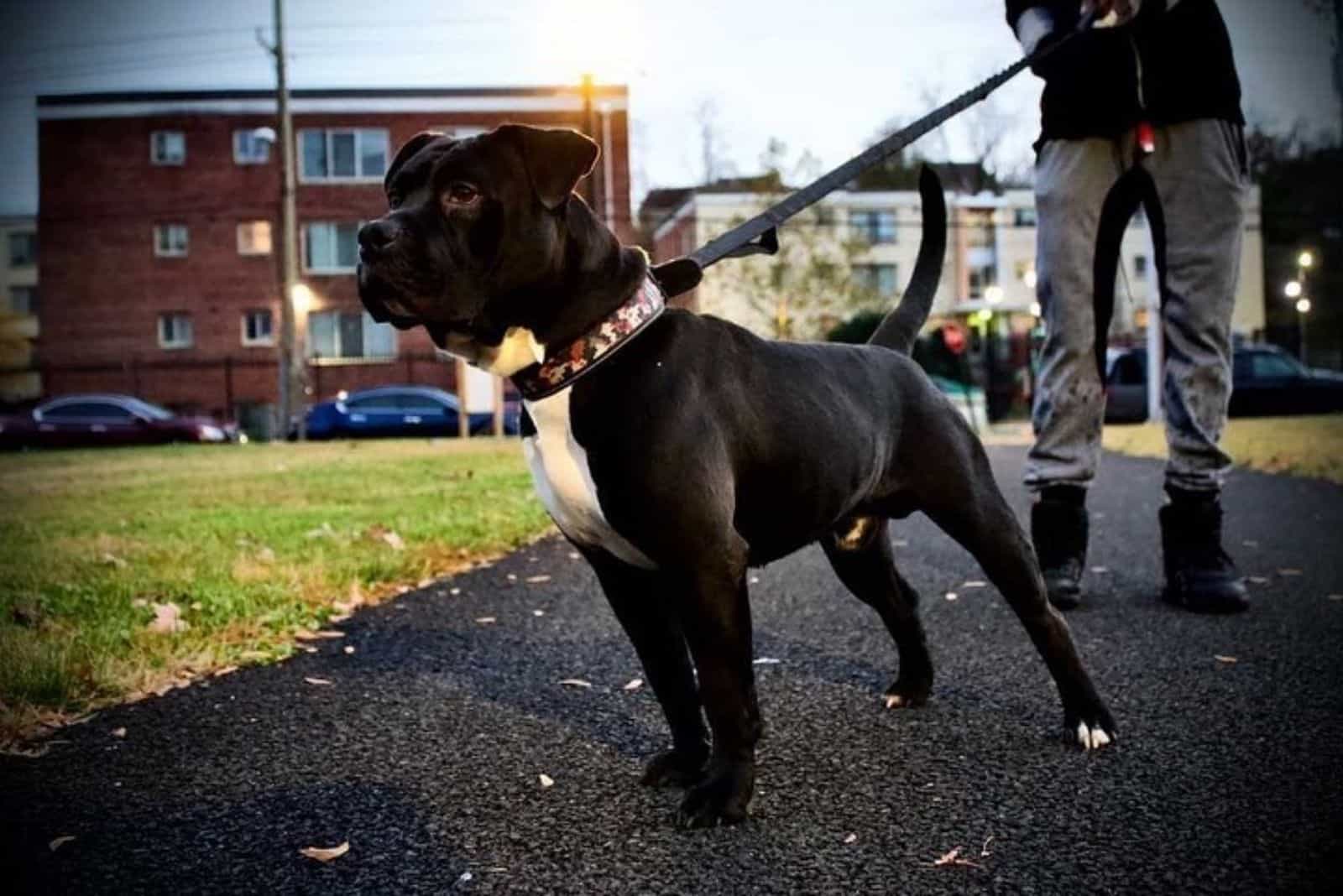The Americans and the English share a unique bond sometimes referred to as the ‘special relationship‘. It’s a connection that stretches back hundreds of years, although it hasn’t always been plain sailing!
And yet, these cousins on either side of the Atlantic ocean generally get on very well these days. We (mostly!) share the same language and have much in common. We also share a love for canines, owning a staggering 100 million dogs between us.
One of these dogs is a relative newcomer, and it captures this connection between the USA and England pretty well. So, what is this mystery dog?
It’s known as the Olde Pit Bulldogge!
To discover more about it, we’re going to take a trip to the past to explore the parent breeds before looking at this unusual dog. We’ll find out what to expect in terms of its health, exercise needs, temperament, feeding, and grooming requirements.
Our journey begins in England five hundred years ago…
The Old English Bulldog
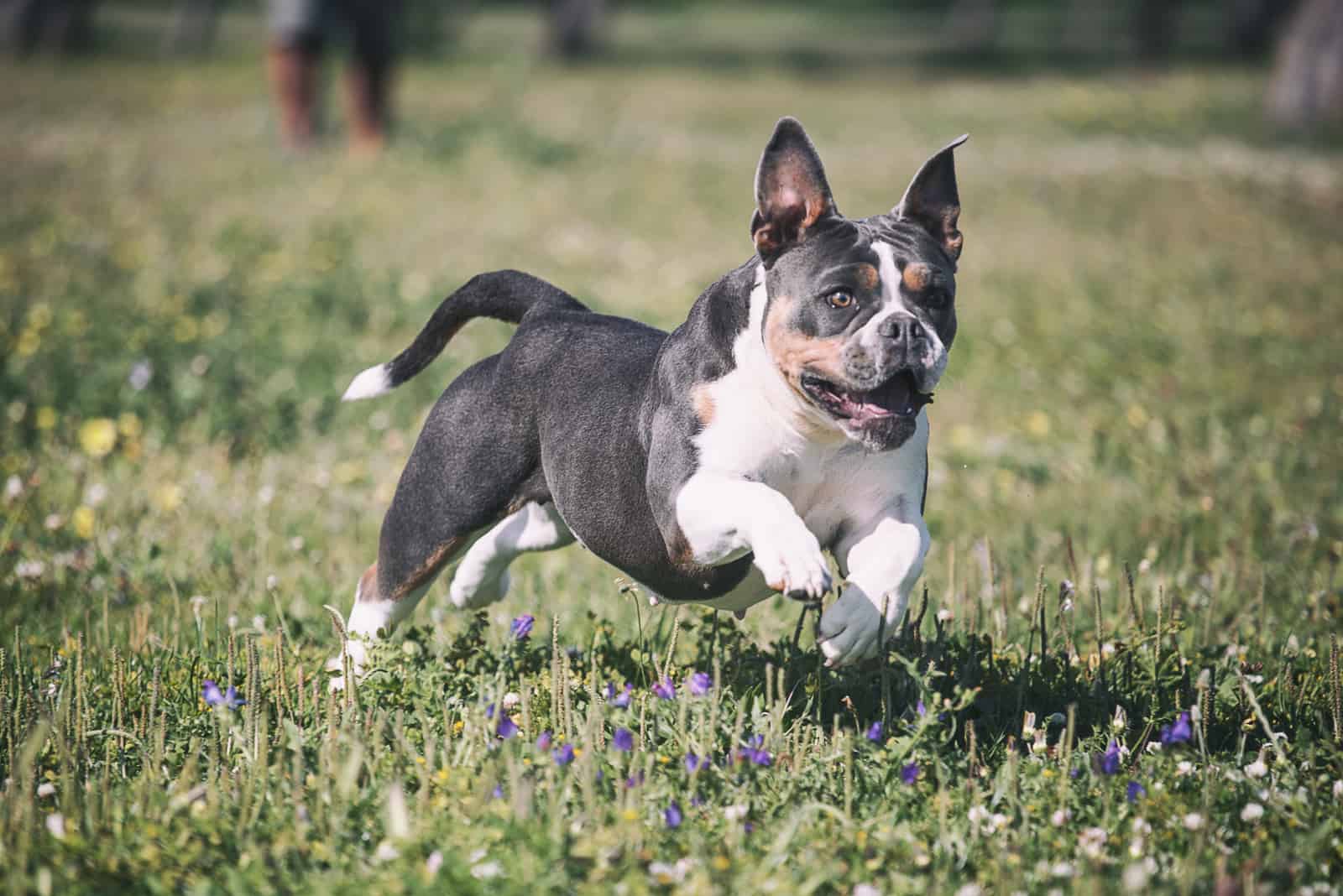
England was a very different place in those days. Hunting was a way of life for the aristocracy and upper classes, and bloodsports were popular across the land at all levels of society.
These ‘sports’ usually involved the gruesome spectacle of getting animals to fight each other. Bears or bulls were favorites as they are big and powerful. These poor creatures were tethered in a ring and dogs would be sent in to attack them. People would place wagers on which dog would bring down the animal or be killed in the process.
To increase their chances of success, dogs were bred to be short, stocky, and incredibly strong. Their jaws had to be strong and wide, and they had a low center of gravity to help them stay on their feet. They had a short muzzle and a wide head, with folds of skin that protected the muscles beneath if the dog was injured.
Many breeders used Mastiff-type dogs to produce the ideal form for the bull pit. Several different breeds similar to the Bulldog had been used for hundreds of years to control livestock. By the 18th century, they were known as Butcher’s Dogs because they were used in this trade to keep cattle in check.
And so, the Bulldog breed was created. It was specially designed to clamp its massive jaws on the bull’s nose and corkscrew around until the bull fell or the dog was shaken off. Bear in mind that the dog weighed around 80 pounds, and the bull weighed around a ton.
The practice of bull-baiting was finally outlawed in 1835. Thankfully, such barbarity is now extremely rare.
By the turn of the century, Bulldogs had found roles elsewhere. Sadly, they were still used for dogfighting, even though this had also been outlawed. As people could no longer set the dogs against bulls, they chose smaller victims in the form of rats. This led to the breeding of Old English Bulldogs with Old English Terriers to create a more streamlined dog with quicker reflexes that was better suited for the task of catching rats.
Known as the Bull and Terrier, this breed was the origin of the Staffordshire Bull Terrier, the American Staffordshire Terrier, and the American Pit Bull Terrier among others. Collectively, these were referred to as pit bulls, a term that is still used today to describe several breeds.
Elsewhere, such as in America, for example, Old English Bulldogs were put to use herding cattle, especially in the southern states where the terrain was too uneven to put up fencing.
As ferocity was no longer needed and people began to keep them as pets, the Bulldog’s gentle nature started to emerge.
However, the breed is officially listed as extinct.
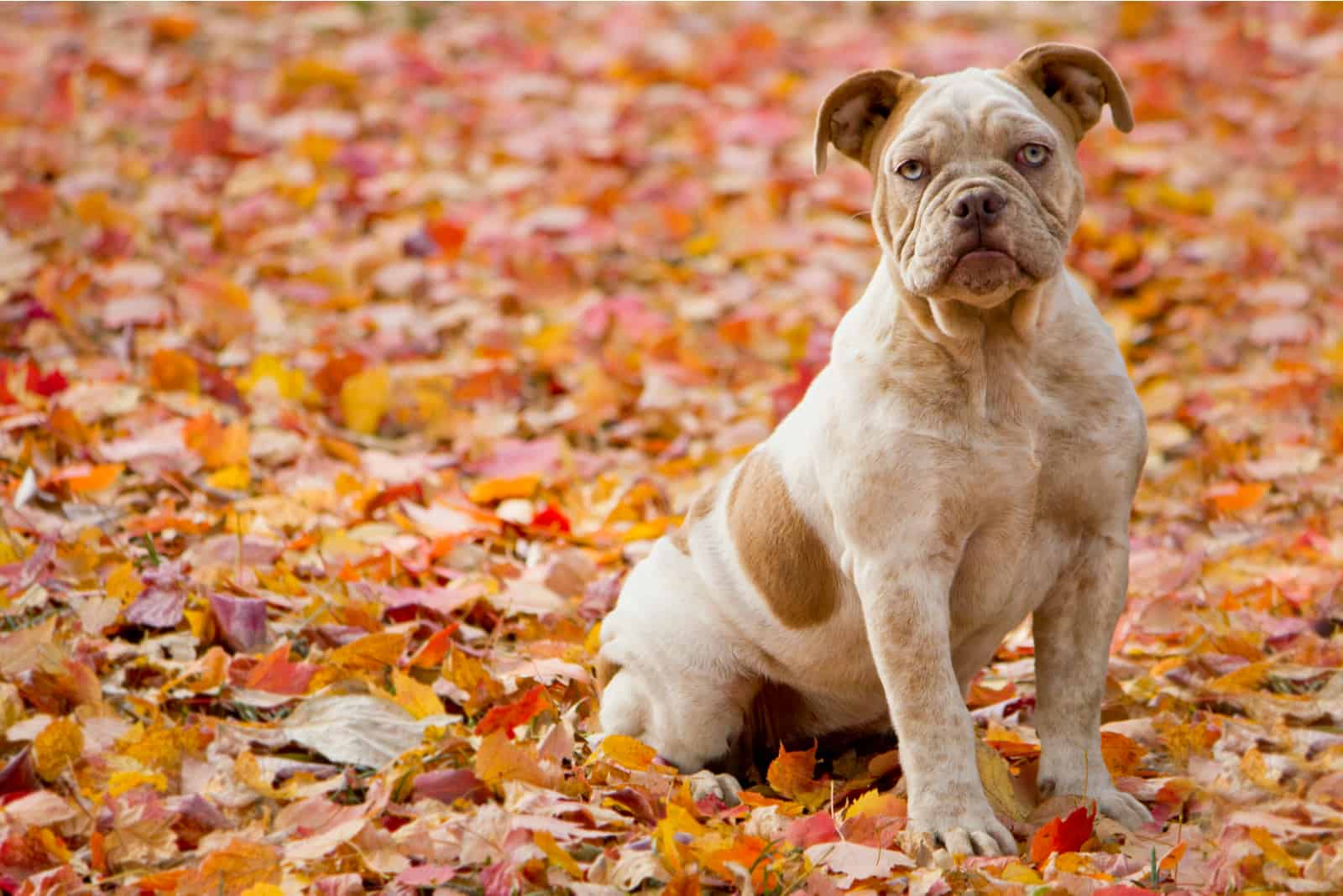
Now, you’re probably thinking, Extinct? Then, how did they make the OEB Pitbull mix?
Yes, it’s confusing, isn’t it? Here’s a quick guide to Bulldogs to help us get things clear:
• The English Bulldog – Also called the British Bulldog or just Bulldog, these are similar to their ‘old’ ancestors, but are classed as a separate breed as they lack ‘gameness’ and are noted for their sweet and gentle nature. There are several physical differences, but otherwise, they are similar in shape. These dogs were developed purely for the show circuit rather than for any practical use.
• The French Bulldog – A much smaller breed, never weighing more than 28 pounds, this bat-eared dog is easily distinguishable from its larger cousins, and there’s no chance of you mistaking it. It is related to the bulldog breeds, although we’re not certain as to which other breeds were used to produce it.
• The American Bulldog – This powerful pooch is related to all those hard-working Bulldogs that came across to the USA with immigrants who set up ranches and farms. There was no place for these dogs in the show ring! They were developed for their muscles and tenacity. It’s a role they continue today, as many of them still work on farms or work as guard dogs as well as make excellent companion dogs. However, if it wasn’t for people like John D. Johnson and Alan Scott, they would have gone extinct.
• The Olde English Bulldogge/Old English Bulldogge/Olde English Bulldog – It isn’t just about fancy spelling. This was a real attempt to recapture the look of the original Regency Period Bulldog as it was in the height of its bull-baiting days. Work began on this process in the 1970s, headed by David Leavitt. He wanted to recreate the same physical characteristics of the Old English Bulldog, but without any of the aggression. By all accounts, he succeeded, producing a sweet and affectionate pooch with an air of confidence about it. Although work started a few decades ago, this breed was only officially recognized by the American Kennel Club (AKC) and the United Kennel Club (UKC) in 2014. Not so ‘Olde’ after all!
So, now we know. The Old English Bulldog is no more. We do still have the English Bulldog, and the Olde English Bulldogge, although there is still a lot of confusion as people often use these names interchangeably.
Because of this, when websites talk about an OEB Pitbull mix, we can’t be sure whether they are referring to the English Bulldog or the Olde English Bulldogge. In all probability, most of these hybrids will have used the OEB, which is why we’ve focussed on this breed in the title.
As you may have surmised, the American Pitbull Terrier is, in fact, related to the Old English Bulldog, so with the OEB Pitbull mix, we’ve almost come full circle!
Meet The Parents
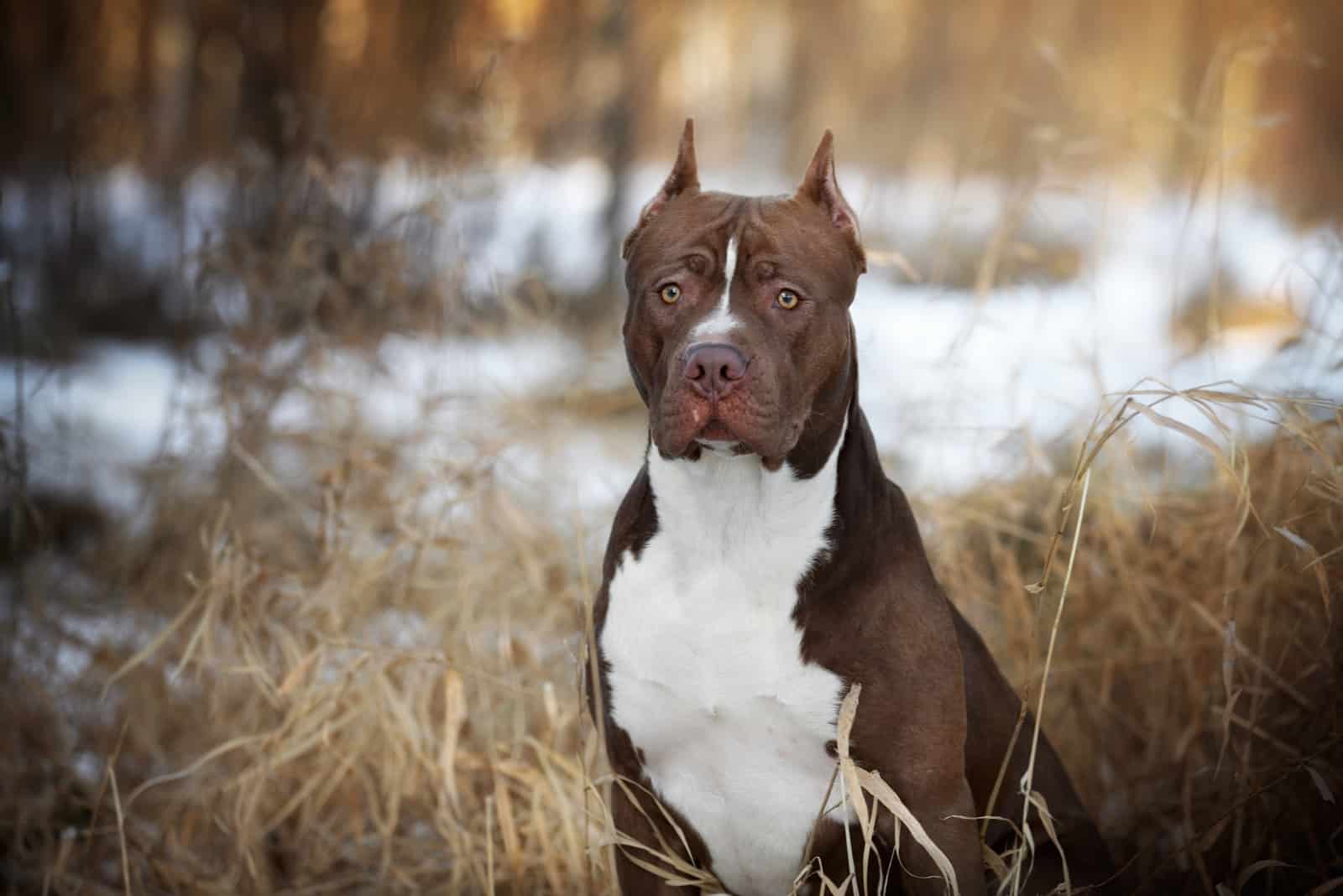
The American Pit Bull Terrier, also (falsely) known as the Pitbull, averages between 17 and 21 inches in height, and weighs between 30 and 60 pounds. Oddly enough, this breed is recognized by the UKC (and others), but not the AKC. This isn’t because the AKC has actively avoided doing so, but because the breed clubs are happy without AKC registration.
They can have an incredible range of coat colors – around twenty-three or so – and these include fawn, white, brindle, gray, blue, black, red, and tan.
They are listed by breed clubs as companion dogs or family dogs, but they have (rightly or wrongly) earned a reputation for being dangerously aggressive (see the section on Pitbull mixes below).
Putting this aspect aside, these are very affectionate dogs with a tendency to clown around. They are intelligent, loyal, and obedient, but they have a stubborn side that surfaces now and again.
We touched on the Olde English Bulldogge earlier, but let’s take a closer look.
This is a large dog, weighing between 65 and 130 pounds! Females weigh a little less; between 60 and 120 pounds.
In terms of height, they’ll measure between 18 and 25 inches at the shoulder, again with females being shorter.
Their coats can be white with brindle, red, or gray patches, or solid black, red, or fawn, and even black & white.
They are true family dogs that love to be active. They are bold, loyal, and protective, and yet still remain placid for the most part.
So, what does all this mean for the hybrid OEB Pitbull mix.
Pitbull Bulldog Mix: The Olde Pit Bulldogge
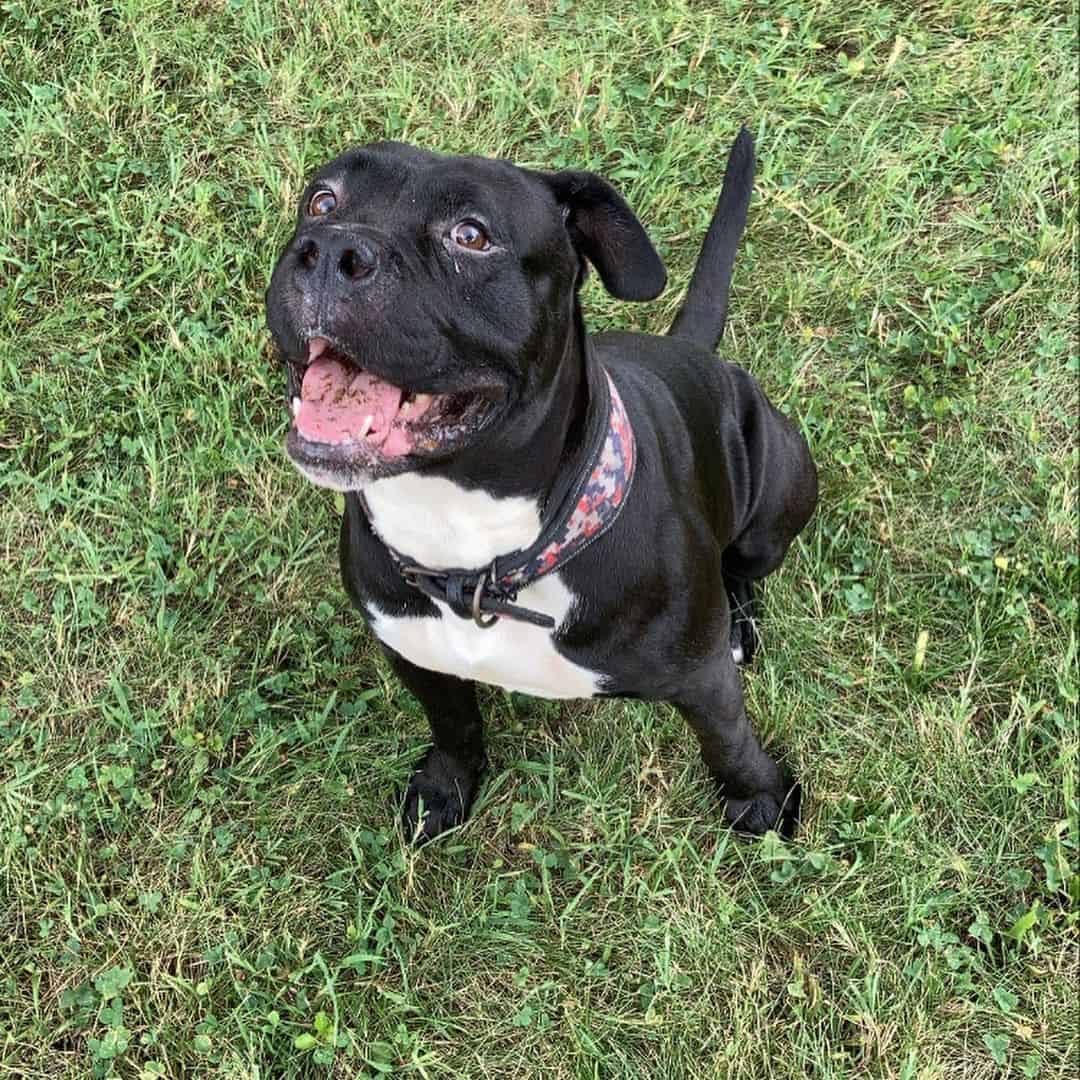
Photo from: @big.boulder
The OEB Pitbull mix is a cross between two powerful dogs that, as we have learned, are already related.
So, what can we expect him to look like?
This dog will be of medium to large build, with a weight range of between 40 and 80 pounds. He’ll stand around 22 inches at the shoulder (females will be smaller; about 17 inches), and will have a solid, muscular body.
His head will be broad, with brown, almond-shaped eyes, and small to medium ears that flop down.
His fur will be short, stiff, and smooth, and it can be black, brown, chocolate, white, cream, gray, or a mix of any of these colors!
As you might expect, this dog will be super loyal, and will be very eager to please you the whole day long. He’ll be laid back, but perhaps wary with strangers. He’ll make a great family pet, but you have to be prepared to attend training sessions and start socialization as early as possible in order to cut out any negative behavior and signs of aggression.
Because he loves his family so much, he’ll be protective, and will certainly make a great watchdog.
If you have young kids in the home, it makes sense to supervise any interaction between them and your dog, but a well-socialized pet shouldn’t be any cause for concern.
What Health Issues Do They Have?
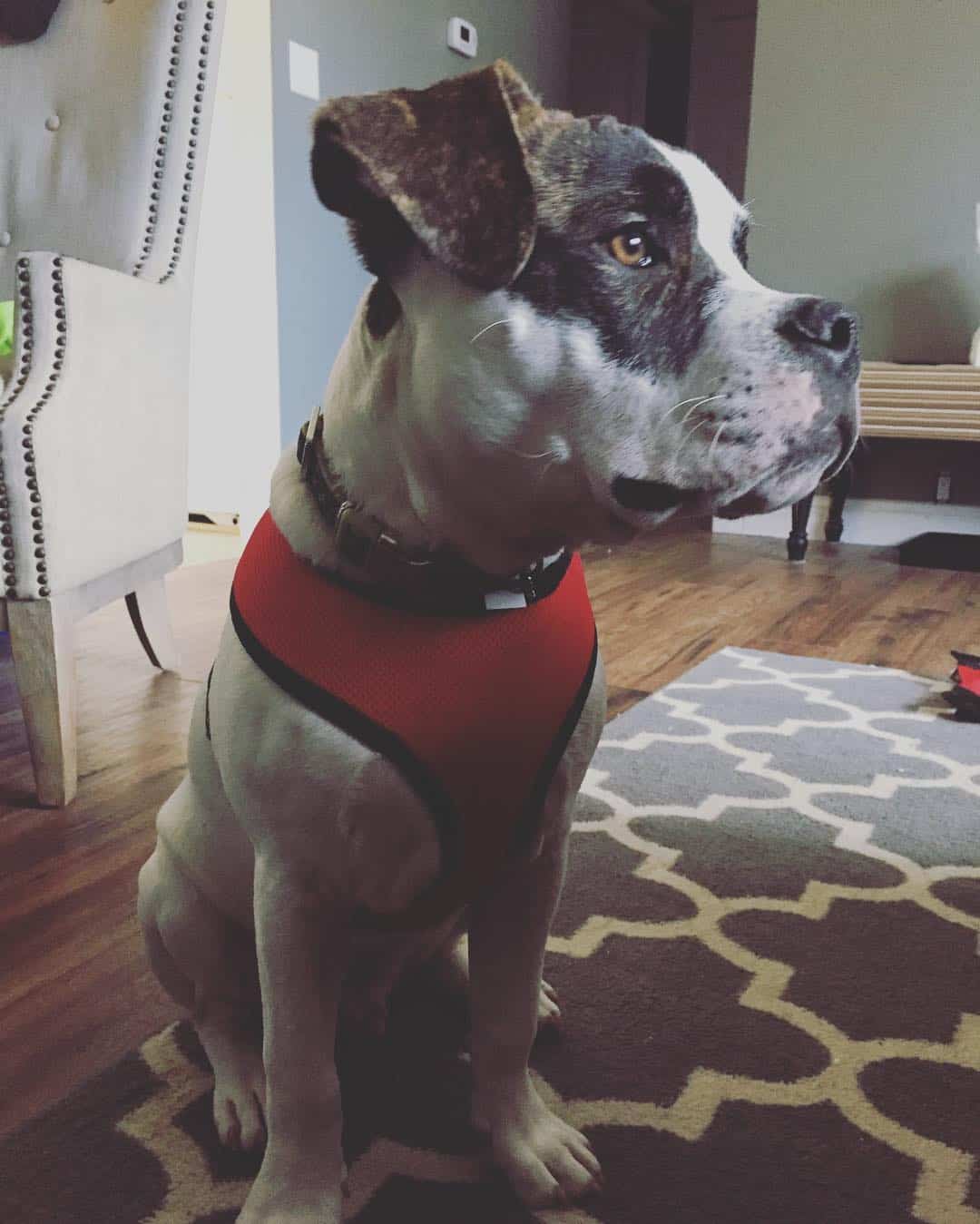
Photo from: @bmerrick89
All dogs have certain health problems that can appear from time to time. Some breeds are healthier than others. Sadly, the Bully breeds have a longer list than most mainly because of their uniquely shaped head and jaw as well as their low, stocky frame.
Here are a few of the common problems that you might find in the parent breeds that could be passed on to the OEB Pitbull mix:
• Hip dysplasia – This painful condition happens when the hip joint doesn’t form properly as the dog develops, resulting in the bones grinding together. Surgery is often needed to fix this.
• Allergies – Bulldogs are particularly prone to allergies for some reason. These can range from mild to severe. Extreme allergies can be life-threatening.
• Skin complaints – Dogs with wrinkles and folds are prone to skin infections and yeast infections. Keeping the folds clean and dry is the best way to reduce the risk.
• Cancer – Bulldogs have always been thought to be more at risk of getting cancer than any other dog breed. The most common form is cancer of the mast cells, which can be surgically removed or treated with chemotherapy. However, new research suggests that there may be some hope. A recent study indicates that many tumors are misdiagnosed, and are actually caused by a non-cancerous condition called polyclonal B‐cell lymphocytosis.
• Heatstroke – All Bully breeds are brachycephalic, meaning that they have a short, wide head, a flat face, and a shortened muzzle (like Pugs and French Bulldogs). Dogs have a naturally long snout for a reason: it is a part of their internal cooling system. As dogs pant, they evaporate moisture from their tongue, nasal cavity, and lungs. As this air passes over the soft tissue, it helps to cool the dog down. Brachycephalic breeds are unable to do this, so they are prone to overheating.
• Epilepsy – In some cases, epilepsy has a known cause, such as organ failure or poisoning. However, in most cases, the cause is unknown, which is referred to as idiopathic epilepsy. Bulldogs are among the breeds that are most at risk of seizures. This condition can usually be managed by using medication.
• Arthritis – This condition is frequently connected with hip dysplasia and being overweight. Extra strain on joints affects the cartilage, causing inflammation and pain.
• Degenerative myelopathy – Usually affecting older dogs, this disease of the spinal cord causes loss of feeling in the hind legs. The dog will start to wobble as it walks, and it will eventually lose the use of its back legs.
• Hypothyroidism – The thyroid gland produces hormones that help the dog’s metabolism to perform as it should. A dog with an underactive thyroid (hypothyroidism) will not produce enough of these hormones, leading to hair loss, lethargy, loss of appetite, and weight gain.
• Heart problems – Bulldogs are susceptible to multiple heart conditions, including pulmonic stenosis. This can cause them to be reluctant to exercise, which can lead to heart failure and death.
• Bloat – Gastric Dilatation-Volvulus (GDV) is a strange condition that can be fatal if not diagnosed quickly. The dog’s stomach swells with gas and starts to twist on itself, cutting off the blood supply to other organs. The real cause is not known, but overeating or eating too quickly, especially if the dog has exercised an hour before or after, is thought to be a contributing factor.
It’s difficult to predict just how much the OEB Pitbull mix will be affected by any of these. Mixed breed dogs are often said to benefit from hybrid vigor, an injection of fresh genes into the gene pool that makes the offspring healthier.
However, the Olde English Bulldogge was itself classed as a mixed breed* for around forty years until it was accepted as a purebred dog by the AKC and the UKC.
Because of the close relationship between these breeds, it’s unlikely that many new genes will be gained.
*a hybrid of the Bulldog, American Bulldog, Bullmastiff, and the American Pitbull Terrier
Lifespan Of The OEB Pitbull Mix
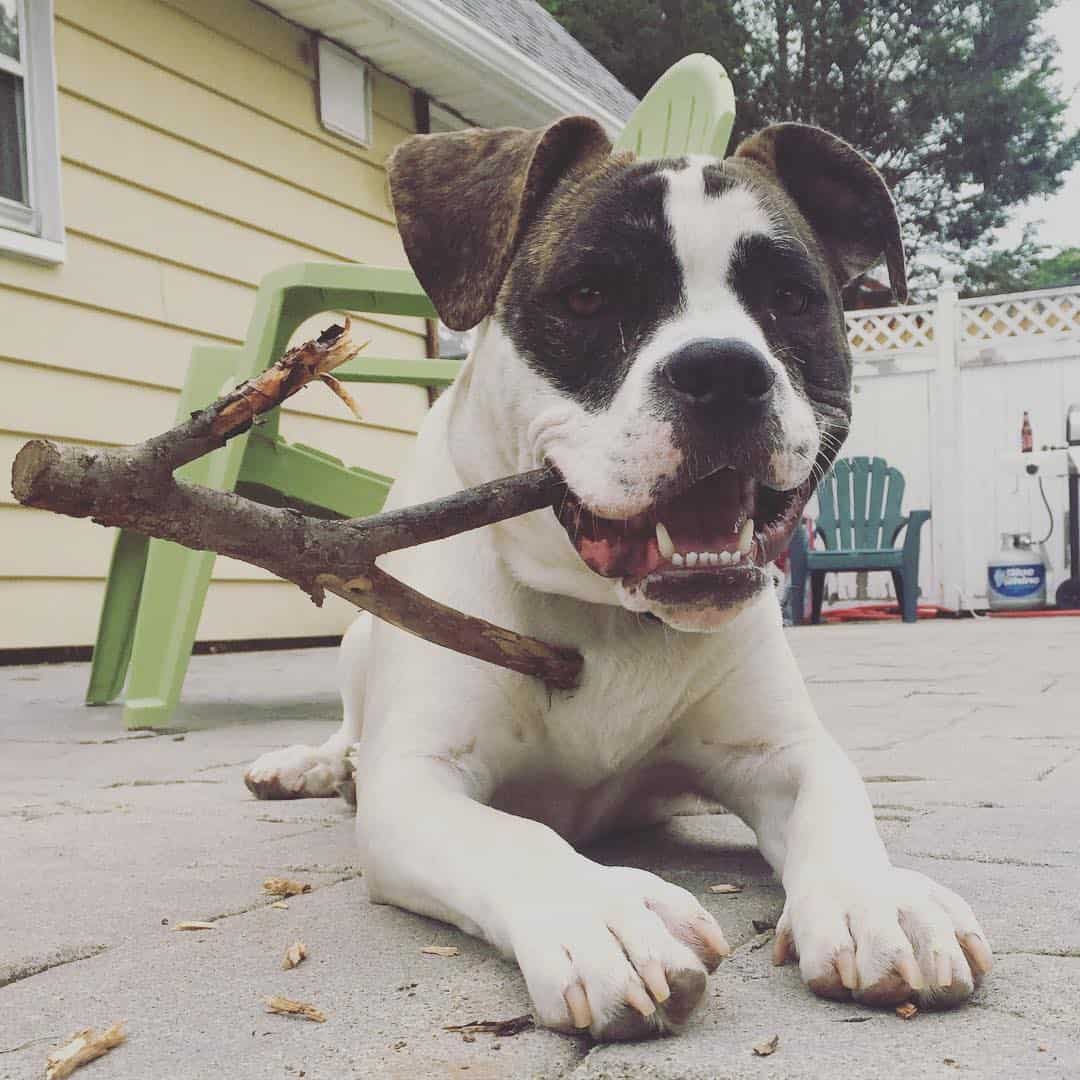
Photo from: @bmerrick89
Your Olde Pit Bulldogge has a good chance of living to the ripe old age of 14 years, maybe a little longer.
On the negative side, they might live for no longer than eight or nine years. This is pretty short for a dog of this size, and it is a reflection of the parent dog’s potential health problems, many of which can shorten their lives.
There are two ways to increase your chances of keeping your furry friend with you longer.
The first is to only use reputable breeders as they will screen their dogs for any potential health problems. They’ll also be on hand to offer you help and advice.
The second thing you can do is give them what they need: plenty of exercise and mental stimulation, good food, and lots of love! As an extra precaution, regular visits to the vet will help catch any problem that might need treatment.
Grooming Requirements
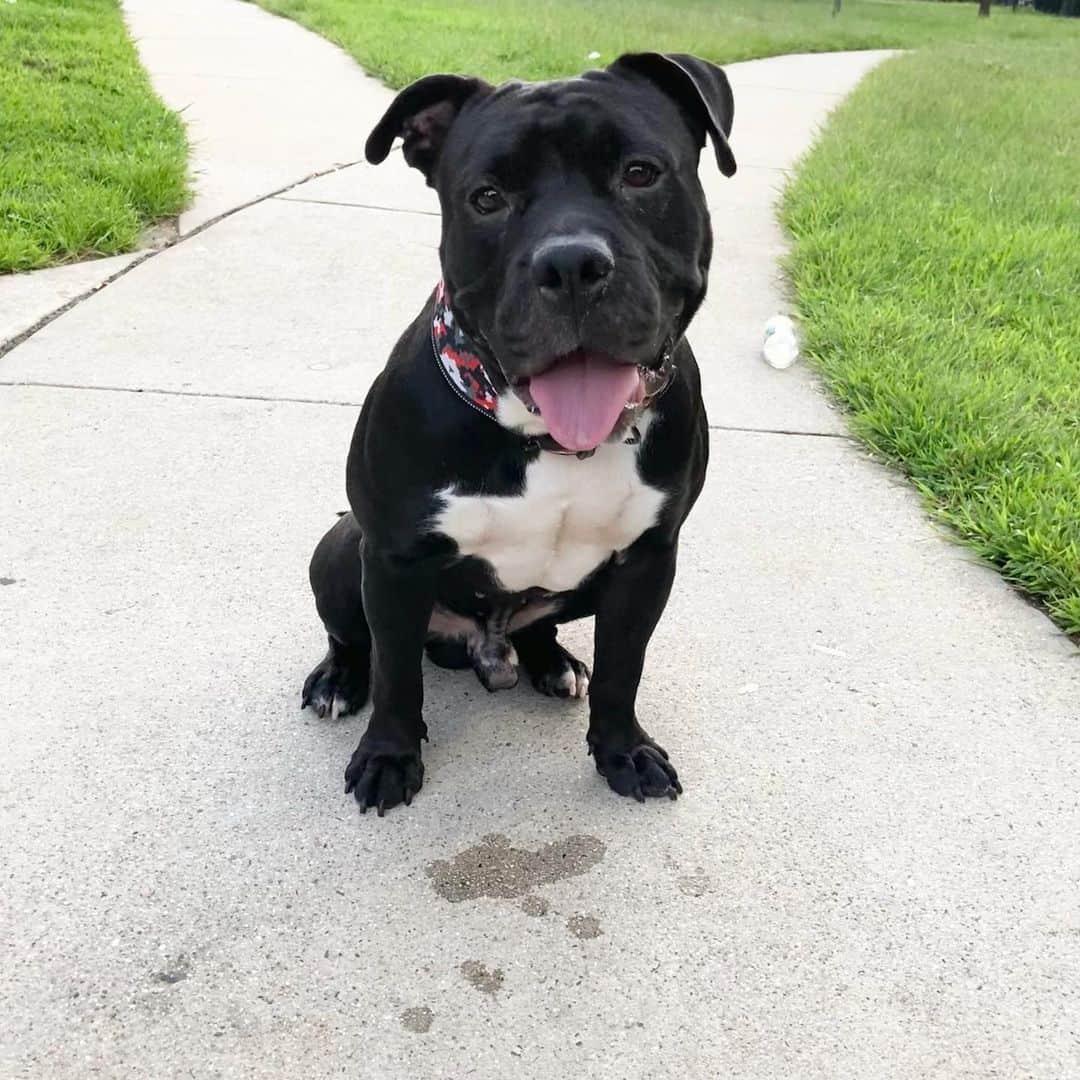
Photo from: @big.boulder
The OEB Pitbull mix is an average shedder, and it will require brushing daily if possible. This is as much for your benefit as for theirs as it will stop the dog hair from getting all over the house. Use a pin brush and go over their coat thoroughly to remove the dead hair. As it’s a short, stiff, straight coat, this shouldn’t take you very long at all.
Proper grooming doesn’t end there, though.
You’ll need to check their eyes and ears as well as any folds and flaps of skin. Look for signs of infection, and make sure all these places are clean.
You might want to invest in a pair of nail clippers to keep those toenails nice and short. If they are allowed to grow too long, they become painful and affect the dog’s ability to walk. This can be a tricky job as you have to be careful not to cut too close to the quick. See if you can find a set with a safety guard which stops you from going too far down.
Alternatively, you can entrust the job to a professional groomer.
Finally, use a dog toothbrush and toothpaste (never use toothpaste designed for humans!) to keep those teeth lovely and clean.
None of this should take up too much of your day, and it will all make for a happier, healthier pooch!
Do They Need A Lot Of Exercise?
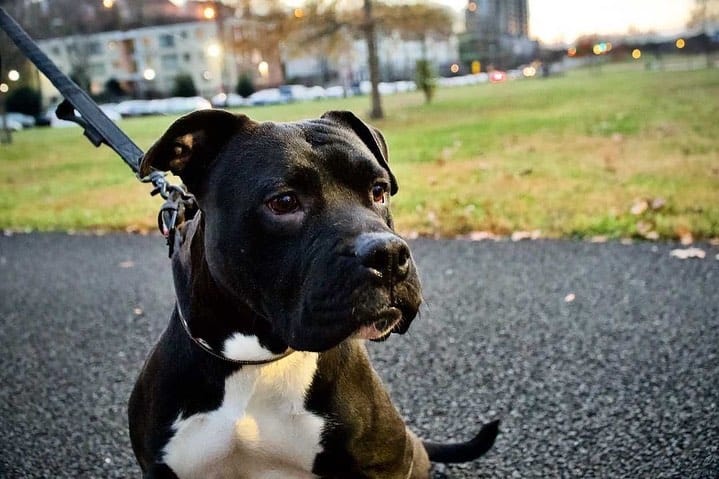
Photo from: @big.boulder
Despite their short, squatty shape and heavy-set bodies, these are pretty active dogs. Give them a good long walk or a run each day, combined with playtime in the yard or at a dog park to use up some of that energy, and aim for this to last about an hour. They’ll need to exercise their minds as well, so invest in some puzzle toys and invent some cool games that will keep them occupied.
A dog that gets a good amount of exercise and mental stimulation is likely to be a happy one. This goes a very long way to reducing any behavioral problems, including aggression and destructive behavior.
Just one word of warning, though: because they are a brachycephalic breed, they may experience difficulty breathing at times, so great care should be taken if they go swimming. Also, because of the tendency to overheat, you should be very careful when you take them out in hot weather.
Always have fresh, cold water on hand, and use a fan to cool them down when you get home. If necessary, soak cloths in cool water and place them on his neck, armpits, and the back of the hind legs.
How Much Food Do They Need?
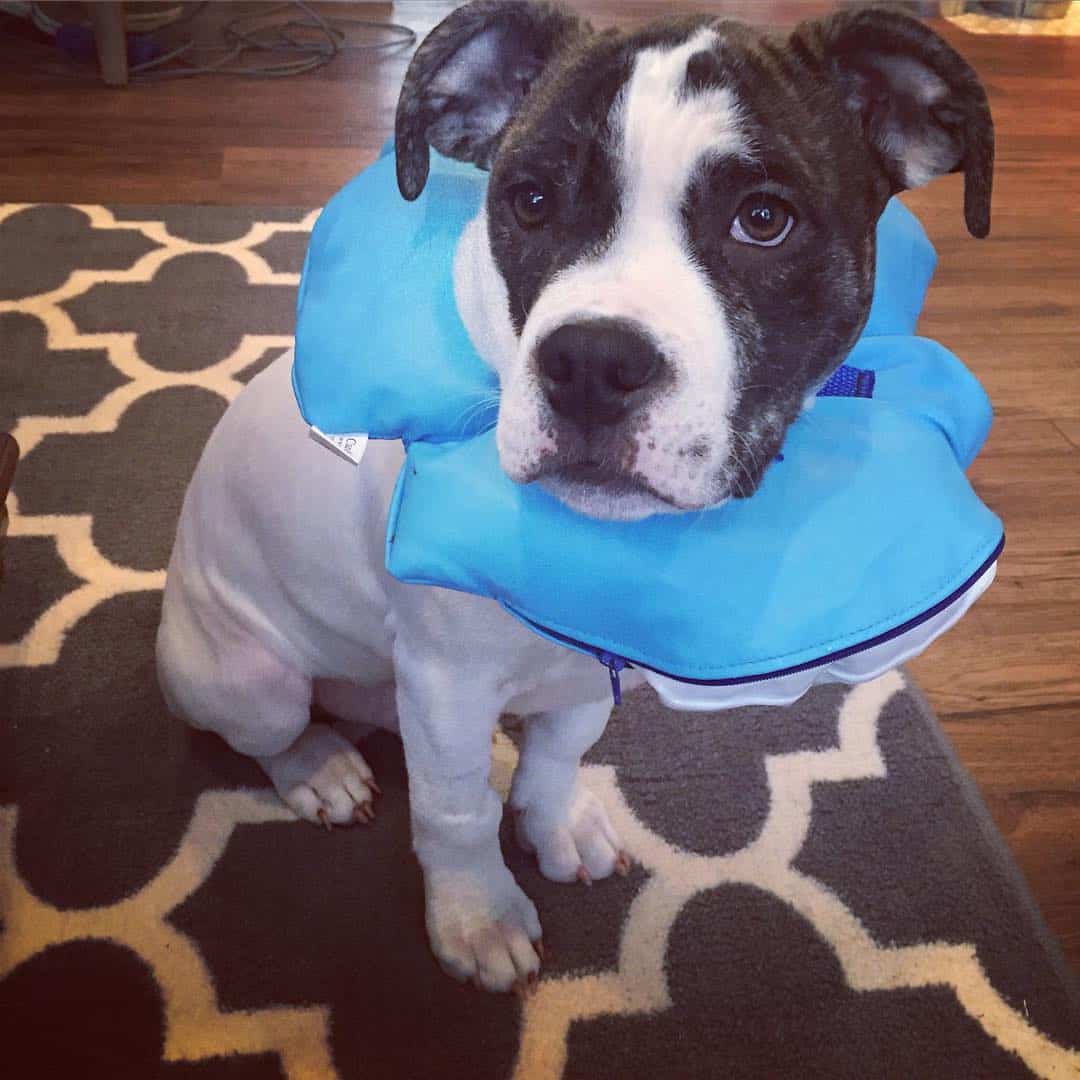
Photo from: @bmerrick89
The OEB Pitbull mix will go through about three cups of dry food each day. At current prices, that’s about $85 per month.
It’s better to feed it three or four small meals a day rather than one or two big meals. This is much healthier for them as it cuts the risk of bloat, and they are able to metabolize the food better.
Don’t be tempted to skimp on their dog food. Invest in a good quality brand, or seek advice on how to make your own food. Treats should be kept to a minimum in order to avoid obesity as this will dramatically increase their chances of getting sick.
In addition to regular high-quality dog food, you can feed your OEB Pitbull mix with certain human foods. Foods such as guava, turnips, artichokes, basil, and tuna can give your dog the necessary nutrients it requires for its daily activities.
American Bulldog Pitbull Mix
It’s only fair to mention this breed, if only to compare it to the others.
Known as the Bullypit, it weighs between 40 and 80 pounds, measures between 20 and 24 inches in height, and has a lifespan of between 10 and 13 years.
In many other respects, it mirrors the OEB PItbull mix, but in one area in particular, it seems to have the edge.
Contrary to all suggestions otherwise, it is a big softy! With the right training and socialization, it makes an excellent family pet, and it is great with kids.
This brings us to a controversial and divisive subject that really can’t be avoided…
Are Pitbull Mixes Dangerous?
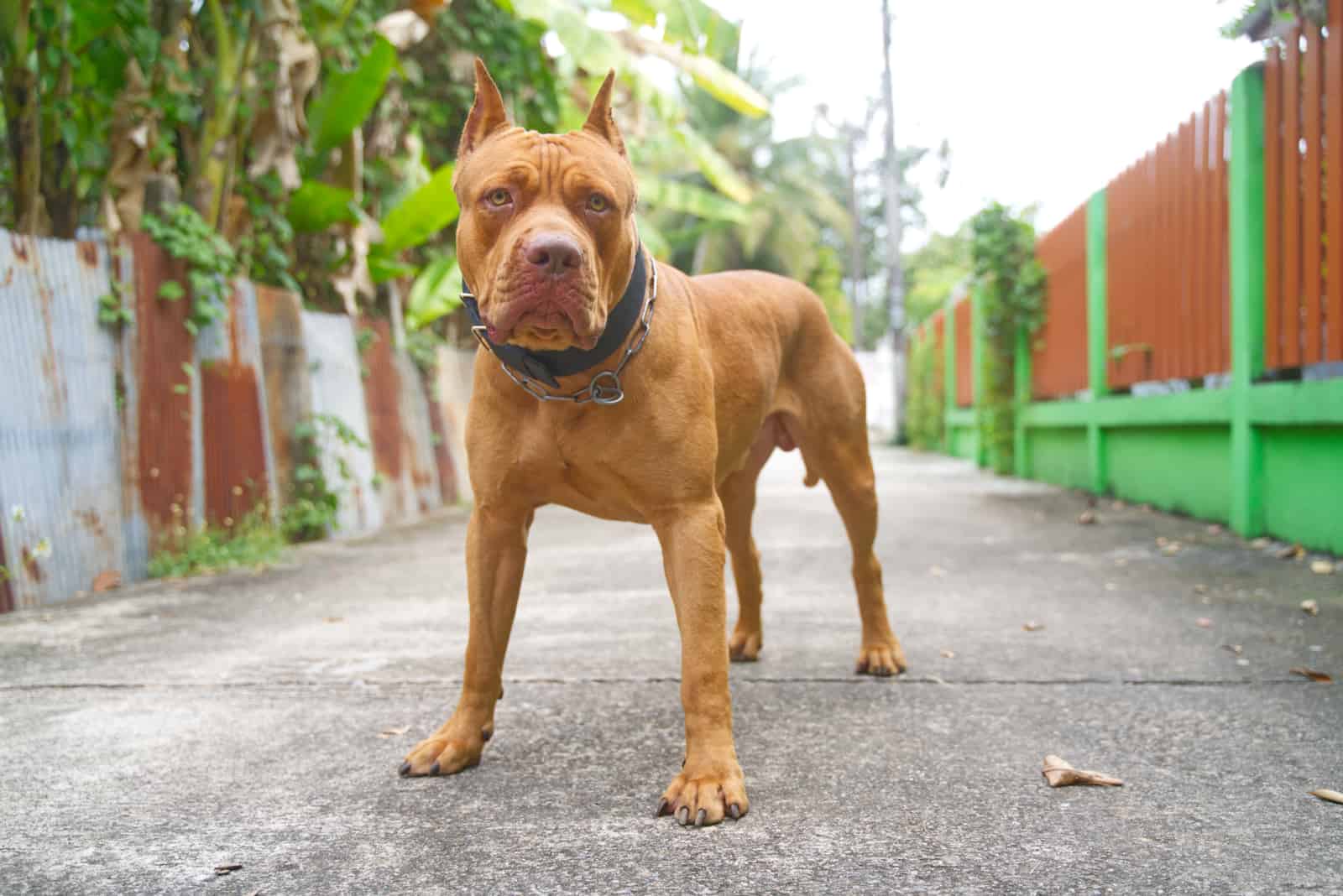
It all depends on who you ask. Google this question and you’ll find some websites waving red flags and shouting at you to avoid Pitbull mixes at all costs. Scroll further down and you’ll see exactly the opposite, with claims that these are perfect dogs that you can trust your kids with.
So, who is right?
To answer this, we must look at the bigger picture. It has often been said that ‘you can prove anything with statistics!‘, and the statistics don’t look good for Pitbull dogs. Making up less than 6% of the dog population in the US, they account for nearly 70% of dog attacks and 52% of dog-related fatalities.
However, take a closer look and you’ll see that these (rather outdated) figures refer to a period going back to 1982. Figures are harder to find now as the CDC no longer lists breed-specific statistics.
Still, it has to be said that reports do show that Pitbull-type dogs are responsible for injuries and deaths in the US, and this trend has grown dramatically in the last two decades.
The real problem doesn’t seem to be the dogs themselves. As usual, it seems that humans are to blame. Many Pitbull lovers enthuse about ‘gameness’ – the dog’s instinct to take on a challenge (such as fighting) without fear and to get the job done or die trying. This trait is encouraged, praised, and treasured, and any suggestions that it should be bred out of the dogs is met with scorn and ridicule.
Also, these dogs have become status symbols for certain sections of society. They’re powerful animals, and those who own them often exude an air of belligerence. These dogs are popular with some criminal elements, and they have even been used as weapons against the police.
Of course, that’s not to say that everyone who owns a Pitbull is a criminal! It’s just that some people really don’t help the cause.
Any dog can be aggressive. Poor breeding and a lack of training, coupled with abuse and neglect, have resulted in some Pitbull dogs becoming aggressive. But, with the right attitude, along with selective breeding, proper training, and socialization, we can create dog breeds that nobody needs to fear.
And, when you look at the American Bulldog Pitbull mix and the OEB Pitbull mix, it looks like we’re on the right track.
Read Next: 3 Pitbull Breeders In Ontario
